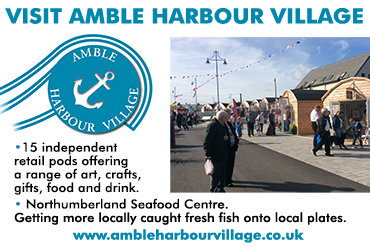A way to process loss: the people behind Amble’s Memorial Clock
Amble’s Memorial clock will be 100 next May. Events are planned to commemorate it. Here, Vivienne Dalgliesh looks at some of the people involved in the creation of the war memorial.
A poignant poem by our very own John Griffiths tells us about Amble War Memorial Clock
‘Oh what a debt we owe to them,
Amble lads never to come back again,
And what a price they had to pay,
So we could have the time of day.’

Amble War Memorial Clock. Photo by Colin Graham.
The foundation stone for the War Memorial Clock was laid in May 1924 by Mr. R.C. McInnes the oldest resident of the town. Mr. Earnshaw, on behalf of Mr. McInnes, appealed to the young people of the town to be ‘the custodians of the future protection of the memorial.’ There cannot be many of them left today, so it is up to us to see that it is cherished.
Some have ignored the appeal and not treated the memorial with respect. There has been stone damage to the clock face, graffiti, five footballs in the roof area and a tennis ball which blocked the drains and did untold water damage. This was not accidental damage. The custodians have had to raise funds too. Repairs have not come cheap; this is a grade II listed building.
It took a lot of hard work to get things started.
Creating the memorial
A public meeting was held in November 1917. Many of those who had died in the war were interred in foreign lands, so it was felt a local focus for people’s grief would be a benefit to the town. Quiet contemplation at the memorial could help townsfolk bear their loss.
A committee was formed from representatives of the community to garner ideas for a fitting tribute. The idea for a clock tower came from Cllr. T. Tully, Chairman of the Council. It was an ambitious project, but moves to raise the funds were put in place.
The land for the memorial was donated by Mr. Edward M. Lawson-Smith, who at the time was living in Tadcaster, but had local connections. Mr. Lawson-Smith lost two sons in the war, John who died aged 22 and Thomas Edward who died aged 25, in separate offensives both in 1914. His loss is noted on the memorial.
The land was valued at £600 and the gift meant that the funds raised could be used towards the memorial itself. The plot was considered an ideal location, right at the bottom of Queen Street and visible from many areas of the town.
A time capsule was placed in the foundations. It contained examples of the current coins of the realm; a book entitled ‘The soul of war’ by Sir Philip Gibbs, which featured the Northumberland Fusiliers; a signed letter from the author in which he paid tribute to the Fusiliers as a man who had followed them in foreign fields; a copy of the ‘Daily News’ from 25 April 1915, it featured an account of the Battle of St. Julien, where many Northumberland Fusiliers had perished; and the names of the Memorial Committee and all the contractors.
Not everything went smoothly. In 1923 when times were hard, a group of ex-servicemen felt that a recreational park would be of greater benefit to the community as a fitting memorial.
Meetings took place and a referendum was held and the proposal was defeated. On the plus side it did reinvigorate the fundraising effort for the clock tower. Money was raised by public subscription, with whist drives, dances, quilt making, auctions and a Grand Bazaar. Key figures in this were Captain Esson and his wife. Mrs Esson was president of the Bazaar Committee and was noted for encouraging the great enthusiasm of the ladies in their various crafts.
The tower was designed by William Burton ARSJ who was surveyor to Amble Urban District Council. It was built by R. Carse and Sons at a cost of £1,390.11s.9d. The inscriptions were sculpted by Messrs Whittle and Sons, at a cost £72.10s.0d. The clock was made by Potts and Sons from Leeds and cost £267.

Belle Chapman in 2000. Belle helped fundraise for the clocktower by laying a trail of pennies. She died in 2008 aged 96
Opening ceremony
The unveiling was performed by Major Vernon Merivale MC. on Saturday 9 May 1925. Two of his brothers, Francis Merivale, who died aged 23, and John William Merivale, who died aged 29, are named on the memorial.
At the unveiling, ownership and responsibility for maintenance was handed over to Amble UDC, but £50 -£60 was still owing. A silver trail of coins was begun around the boundary wall to make up the deficit. This was started by two children who had lost their fathers to the war, Bella Turnbull (father Robert Henry Turnbull, died aged 30, one of three brothers named on the memorial) and John Mackay (father Alexander Mackay died aged 34).
I remember Belle Chapman (nee Turnbull) giving me a copy of her memoirs to read, starting the trail was an occasion she never forgot.
The unveiling was attended by thousands. There was a procession through the town, led by the regimental band of the Northumberland Fusiliers supported by the bands of Amble and Radcliffe. A guard of honour was provided by 36 men from C Company, Northumberland Fusiliers. Floral Tributes were laid, prayers were said and hymns sung, culminating in the National Anthem.
This practice has continued for many years, but the marching through the town stopped when the veterans of WW2, including my father, were too old to continue.
The site as it appears today was constructed in 2000, with the creation of the Town Square. The original boundary wall was retained.
There are 124 from WW1 and 63 from WW2 on the memorial. No ranks are mentioned, all were equal in death. To see them visit the site or www.newmp.org.uk
Vivienne Dalgliesh













Very interesting article,I was born in Amble didn’t know any of these events, but do remember Belle Chapman – lovely lady.
Loved John Griffith poem.